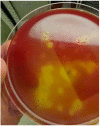Clostridium haemolyticum Infection: A Cause of Hemolytic Anemia in a Patient with Bone Marrow Necrosis
- PMID: 34442646
- PMCID: PMC8399981
- DOI: 10.3390/microorganisms9081568
Clostridium haemolyticum Infection: A Cause of Hemolytic Anemia in a Patient with Bone Marrow Necrosis
Abstract
Clostridium haemolyticum is a sporulating Gram-positive anaerobic rod that is considered to be one of the most fastidious and oxygen-sensitive anaerobes. It is a well-known animal pathogen and the cause of bacillary hemoglobinuria primarily in cattle. To date, human infections caused by C. haemolyticum have been reported in three patients with malignant underlying diseases. We present herein the case of a 30-year-old obese woman with no significant past medical history who developed bacteremia caused by C. haemolyticum with massive intravascular hemolysis associated with bone marrow necrosis and acute renal failure. Because of subculture failure, the diagnosis was made on the basis of 16S rDNA sequencing and next-generation sequencing. The patient, who had been afebrile for 20 days after a 17-day-course of antibiotics, experienced a second bacteremic episode caused by C. haemolyticum. After having been successfully treated for 42 days with clindamycin and amoxicillin-clavulanic acid, the patient developed acute myeloid leukemia as a result of bone marrow regeneration. Although uncommon in humans, infections caused by C. haemolyticum are severe and should be considered in a febrile patient who has severe hemolytic anemia. This case also highlights the importance of using molecular techniques for the identification of this fastidious anaerobic organism.
Keywords: Clostridium haemolyticum; bone marrow necrosis; hemolytic anemia; human infection.
Conflict of interest statement
The authors declare no conflict of interest.
Figures


References
-
- Rainey F., Hollen B.J., Small A., Genus I. Clostridium. In: De Vos P., Garrity G.M., Krieg N.R., Ludwig W., Rainey F.A., Schleifer K.H., Withman W.B., editors. Bergey’s Manual of Systematic Bacteriology. 2nd ed. Volume 3. Springer; Dordrecht, The Netherlands: Heidelberg, Germany: London, UK: New York, NY, USA: 2009. pp. 738–828.
Publication types
LinkOut - more resources
Full Text Sources
Miscellaneous

